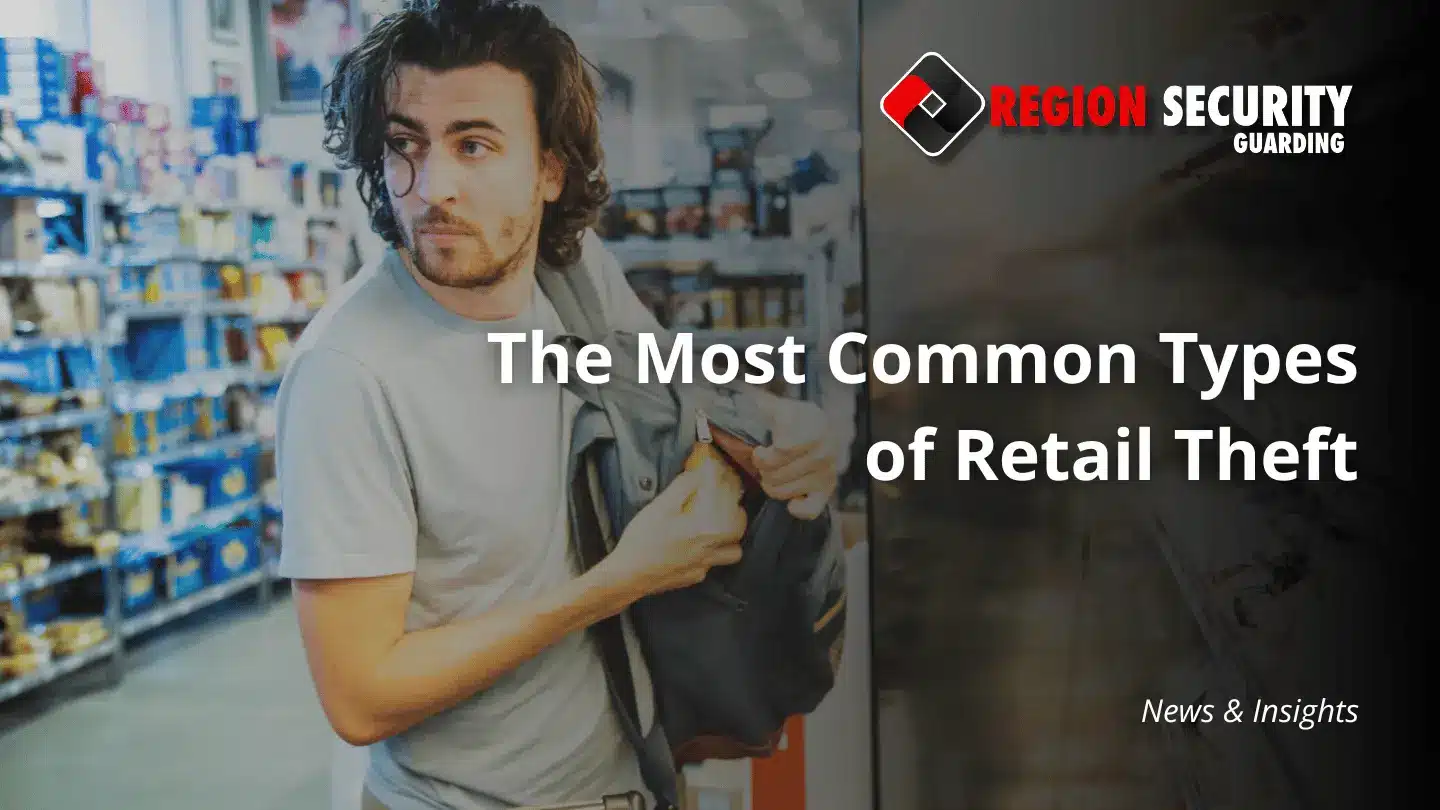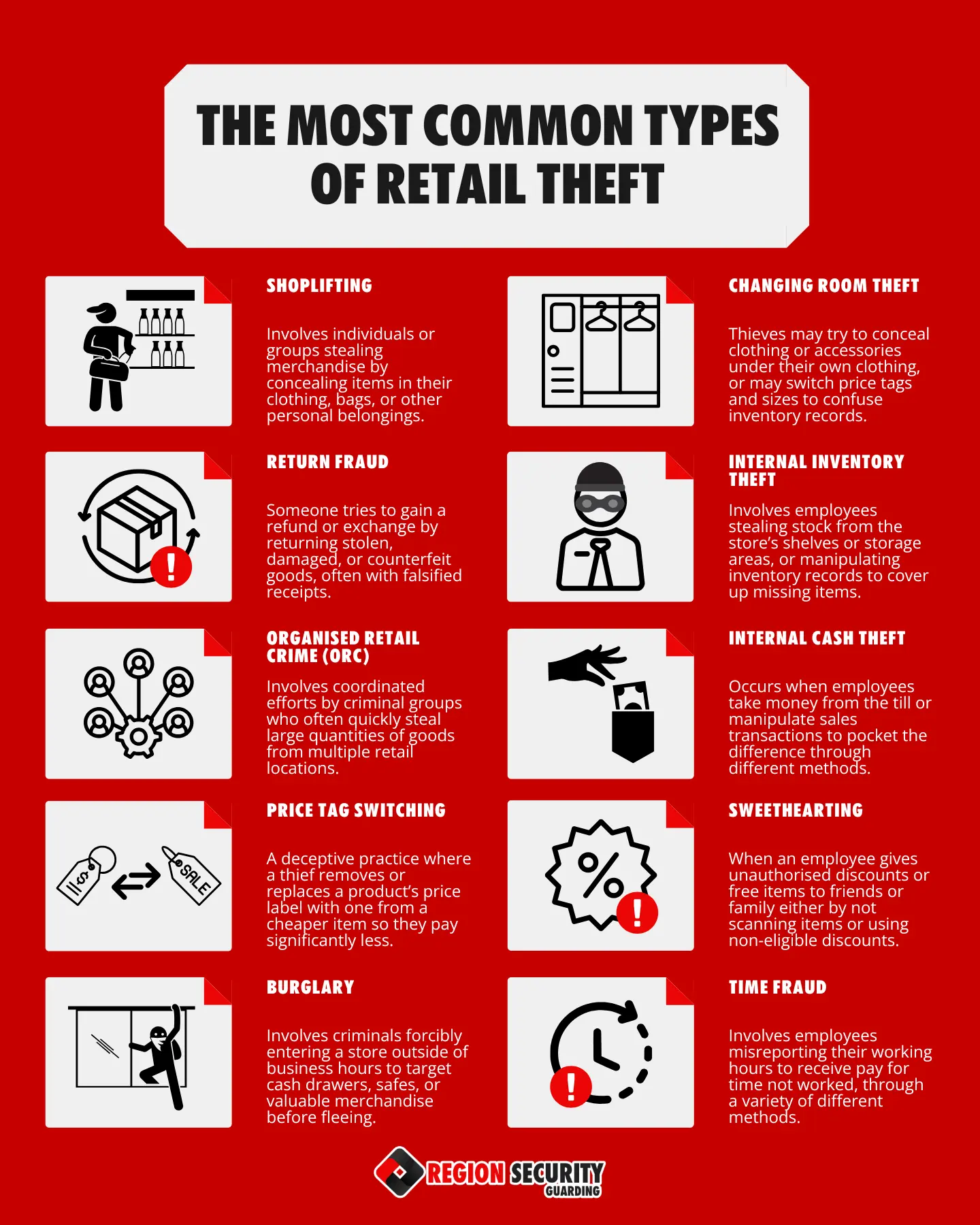Retail theft is a constant challenge for businesses of all sizes across the UK. Regardless of the type of outlet you run, theft can significantly impact your profits and daily operations. With over 20 million cases reported last year alone, it’s no surprise that business owners are investing more heavily in protecting their storefronts.
In this guide, we’ll explore the most common types of retail theft, explain why they occur, and offer practical tips to help you secure your business.
Table of Contents

Why Does Retail Theft Happen?
Retail theft can be driven by many factors. In some instances, it’s opportunistic — criminals take advantage of weak or non-existent security measures. In other cases, it’s motivated by financial hardship, peer pressure, organised crime, or internal staff misconduct.
According to recent reports, retail crime is costing businesses upwards of £4 billion annually, including the cost of crime prevention. Notably, £2.2 billion of that is attributed directly to customer theft, highlighting the importance of strong security practices.
The Core Categories of Retail Theft
Despite the wide variety of methods, retail theft falls into two core categories:
- External Theft: This includes theft committed by customers or other non-employees. It often includes crimes like shoplifting, burglary, or return fraud. It is often more visible but can be carried out in more subtle or organised ways.
- Internal Theft: This involves theft by employees. It could range from stealing stock to falsifying time sheets. Although harder to detect, internal theft accounts for roughly 40% of all retail theft cases.
The Most Common Types of External Theft
Shoplifting
Shoplifting is the most recognised form of retail theft and involves individuals or groups stealing merchandise by concealing items in their clothing, bags, or other personal belongings. It also accounts for almost 50% (48%) of all losses storefronts suffer from. This type of theft often targets easily portable and high-value items such as cosmetics, electronics, or clothing.
To reduce the risk of shoplifting, businesses should install high-quality CCTV systems that cover key areas like entrances, exits, and product displays. Additionally, training staff to be attentive, maintain a strong presence on the shop floor, and engage with customers can discourage potential thieves as well.
Return Fraud
Return fraud occurs when someone tries to gain a refund or exchange by returning stolen, damaged, or counterfeit goods, often with falsified receipts. In some cases, criminals may use discarded receipts found in the bins or manipulate digital returns processes to gain store credit or cash. This type of fraud can be harder to detect, particularly in businesses with lenient return policies or overwhelmed staff.
To combat return fraud, retailers should implement clear return policies that require proof of purchase or photo identification for returns. Limiting the return window and logging customer return histories can also help flag repeat offenders. Receipts should also be cross-checked with the store’s digital sales system if and when possible, as well.
Organised Retail Crime (ORC)
Organised Retail Crime involves coordinated efforts by criminal groups who often steal large quantities of goods from multiple retail locations. These operations can include roles such as distractors, lookouts, and loaders, making the theft quick and difficult to intercept.
To mitigate the risks of ORC, businesses should train staff to recognise signs of coordinated activity, such as large groups entering together or attempts to divert attention. Working with neighbouring businesses and local police can also help track repeat offenders and share information about ongoing threats.
Price Tag Switching
Price tag switching is a deceptive practice where a thief removes or replaces a product’s price label with one from a cheaper item. This allows them to pay significantly less that the actual value of the product when it’s scanned at checkout.
To prevent price switching, employees should be trained to verify prices during checkout, particularly on high-value items. Frequent stock checks and shelf audits will also help to identify items with altered labels. Some retailers also use tamper-resistant labels or digital price tags, which make it harder for tags to be swapped without staff noticing.
Burglary
Burglary in retail settings typically involves criminals forcibly entering a store outside of business hours, often by smashing windows or forcing entry through doors. These incidents are usually planned and executed quickly, with burglars targeting cash drawers, safes, or valuable merchandise before fleeing.
To deter burglaries, store owners should reinforce entry points with security shutters, alarm systems, and motion-activated lighting. Businesses may also consider monitored alarm systems or security guard patrol services to provide rapid responses out-of-hours.
Changing Room Theft
Changing rooms offer privacy that can be exploited by thieves to conceal clothing or accessories under their own clothing. Offenders may take in multiple items and leave with fewer, or switch price tags and sizes to confuse inventory records. Due to the secluded nature of changing rooms, this form of theft is especially difficult to monitor without compromising customer privacy.
Retailers can reduce changing room theft by assigning staff to monitor how many items customers take in and out. Installing call buttons or intercoms can help ensure staff check in regularly without appearing intrusive. Additionally, limiting the number of items per customer and performing periodic checks can help deter and detect suspicious activity.

The Most Common Types of Internal Theft
Inventory Theft
Inventory theft involves employees stealing stock from the store’s shelves or storage areas. It can also take the form of manipulating inventory records to cover up missing items. In some cases, employees may plot with others by allowing merchandise to “disappear” during stock deliveries or waste disposal.
To prevent this, business owners should perform regular inventory audits and implement strict control processes. Automated inventory systems can help identify discrepancies, and restricted access to storerooms ensures only authorised staff handle stock. Performing background checks during the hiring process can also help reduce the risk of hiring individuals with a history of theft.
Cash Theft
Cash theft typically occurs when employees take money from the till or manipulate sales transactions to pocket the difference. This may include “no-sale” transactions, fake refunds, or undercharging customers and keeping the change.
Using point-of-sale software and tracking cash flow and flag suspicious transactions is key. Regular till counts, random audits, and clear accountability for handling cash can help reduce temptation. CCTV monitoring focused on tills also acts as a visual deterrent and supports investigation if a theft does occur.
Sweethearting
Sweethearting is when an employee gives unauthorised discounts or free items to friends or family at the checkout. This can happen by not scanning items, using invalid promo codes, or applying staff discounts to non-eligible customers.
To tackle sweethearting, retailers should review transaction data for patterns such as frequent price overrides or excessive voided items. Managers should monitor till activity and use CCTV at checkouts. Setting clear policies about staff conduct and offering whistleblower channels can also help reduce internal dishonesty.
Time Fraud
Time fraud involves employees misreporting their working hours to receive pay for time not worked. This could be through “buddy punching”, late arrivals, or extended breaks not logged. While it may not involve stolen products or cash, it can still cause significant financial loss over time.
Introducing digital time-tracking systems can automate attendance logging and reduce manipulation. Clear policies on punctuality and regular one-on-one meetings with staff can help identify and address issues early. Encouraging a culture of accountability ensures employees are aware that dishonest timekeeping won’t be tolerated.

How to Protect Your Store
To stay ahead of retail crime, consider the following strategies:
- Train Your Staff: Teach them to spot suspicious behaviour and handle incidents appropriately.
- Invest in Surveillance: CCTV systems and mirrors can help to deter and detect theft.
- Display Policies Clearly: Reinforce rules around returns, timekeeping, and conduct.
- Engage with Local Authorities: Build good relationships with police for quicker response times.
- Hire Retail Security Guards: Uniformed officers act as a strong deterrent and provide fast incident response.
- Keep Incident Logs: Track theft patterns and review for future prevention.
Conclusion
Retail theft is a persistent threat that affects businesses both financially and operationally. By identifying common tactics and understanding how both internal and external theft occurs, retailers can take proactive steps to reduce risks.
With the right security strategies — ranging from staff training to professional guarding services — you can create a safer environment for your team and customers alike. Investing in theft prevention isn’t just about loss reduction, but also about taking a step towards long-term business success and peace of mind.
Business Security You Can Rely On
Trusted by leading businesses nationwide for reliable, 24/7 protection.
or call 0330 912 2033

We have used Region security for quite a while now. Top notch service, great guards and helpful staff. We love our guards and the team for all of their help / work.
No need to try the other companies at all.”
Andy Yeomans – Jones Skips Ltd
Great company, professional services, friendly guards and helpful at times when required.”
Rob Pell – Site Manager
A professional and reliable service. Always easy to contact and has never let us down with cover. No hesitation in recommending and competitively priced also.
After using an unreliable costly company for several years it is a pleasure to do business with Region Security”
Jane Meier – Manager
Region Security were very helpful in providing security for our building. We had overnight security for around 4 months. The guards themselves were professional, easy to reach and adapted very well to our specific needs. Would definitely recommend Region for security needs.
Lambert Smith Hampton
Great service. Reliable and professional and our lovely security guard Hussein was so helpful, friendly but assertive with patients when needed. He quickly became a part of our team and we would love to keep him! Will definitely use this company again
East Trees Health Centre
Fantastic Service from start to finish with helpful, polite accommodating staff, we have used Region Security a few times now and always been happy with what they provide.
Leah Ramsden – Manager




